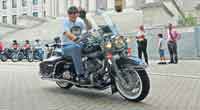|
The Chinese puzzle A motorcycle means different things to different people. It can be status symbol and dream machine for one and commonplace workhorse for another. I know a number of owners who think of their bikes in terms of both worlds - dream and reality. These people get the most out of their Benlys, CM 125s, Suzuki GNs, and even the humble 50 and 70cc machines (I don't want to leave out the Indian bikes. In this day and age, we can't quite leave out the Hero Hondas, can we?). Watch the happy rider zooming into the distance on his modest, nondescript two wheeler. It's all in the mind, or is it? I suppose it is, until you get suddenly overtaken by a V-4 something or the other. Something bigger, faster and, let's face it, infinitely more desirable than the mass-produced 125cc which, until then, made you feel like king of the road. They are all mass-produced nowadays (there are no longer any George Broughs painstakingly handcrafting two wheeled Rolls Royces in garden shed factories). But a mass-produced four-cylinder bike is a different story altogether from your modest, mass-produced parallel twin. It's a different kind of mass we're talking about.
For one thing, few owners, and even fewer onlookers, would think of them as everyday transport - just to get from home to office and back. In the West, though, this feature is becoming increasingly important - hence, reviewers are at pains to show that a given model is practical transport in urban traffic. But the commuting part, in that context at least, is secondary. What is important is the bike's ability to make heads turn in the open. I mentioned the V-fours. Why didn't I mention the vee-twins? Because that's pretty obvious. Say vee-twin, people think of Harley Davidson. It seems to me that the motorcycling world is divided into three parts - those who own Harleys, those who say they don't want to own one (these are the aficionados of Japanese cruisers), and those who dream of owning a Harley. The third world, I suspect, is full of the latter (a young woman executive at an advertising firm, who's never ridden anything bigger than a bicycle, once told me that her life's ambition was to buy a Harley. I wonder how she travels to work now). Let's face it. Given the circumstances of our lives, most of us aren't likely to own a Harley Davidson in our miserably short lifetimes. But things aren't as bad as all that. At any rate, the Chinese have come up with a solution. They have built a range of very pleasing, scaled down imitation Harleys for their third world customers. Buy one and have the trip of your lifetime at a fraction of what it costs to buy (and run) the Milwaukee product. The Chinese version is very cleverly done. Much of the chrome is actually plastic, but it gleams as well as anything which comes out of the foundries. The engines are tiny - 125cc, and even 100cc. But they look like proper vee-twins. Equipped with footboards, panniers, top boxes, extra lights and saddle bags, the Chinese bikes look bigger than they actually are - a tribute to human ingenuity and the power of make-believe. Harleys are notoriously prone to mechanical trouble. The Chinese look-alikes are notorious for falling apart ever so quickly. Nevertheless you get what you pay for (if that's true, what will you say when your Harley's horrendously expensive but trouble-prone pre-Evolution engine breaks down once again?). We are forgetting that all important factor, mystique. Believe it or not, these gleaming and fragile toys made in China have it in plenty. Figure it out for yourself - word has got around by now that appearances are deceptive in this case, but I see newly-registered imitation Harleys on our roads every day, when they should have disappeared long ago if you go strictly by the hard logic of marketing. Thankfully, logic has little to do with motorcycles, and I hope it stays that way. |
||||
Copyright © 2006 Wijeya Newspapers
Ltd. All rights reserved. |
